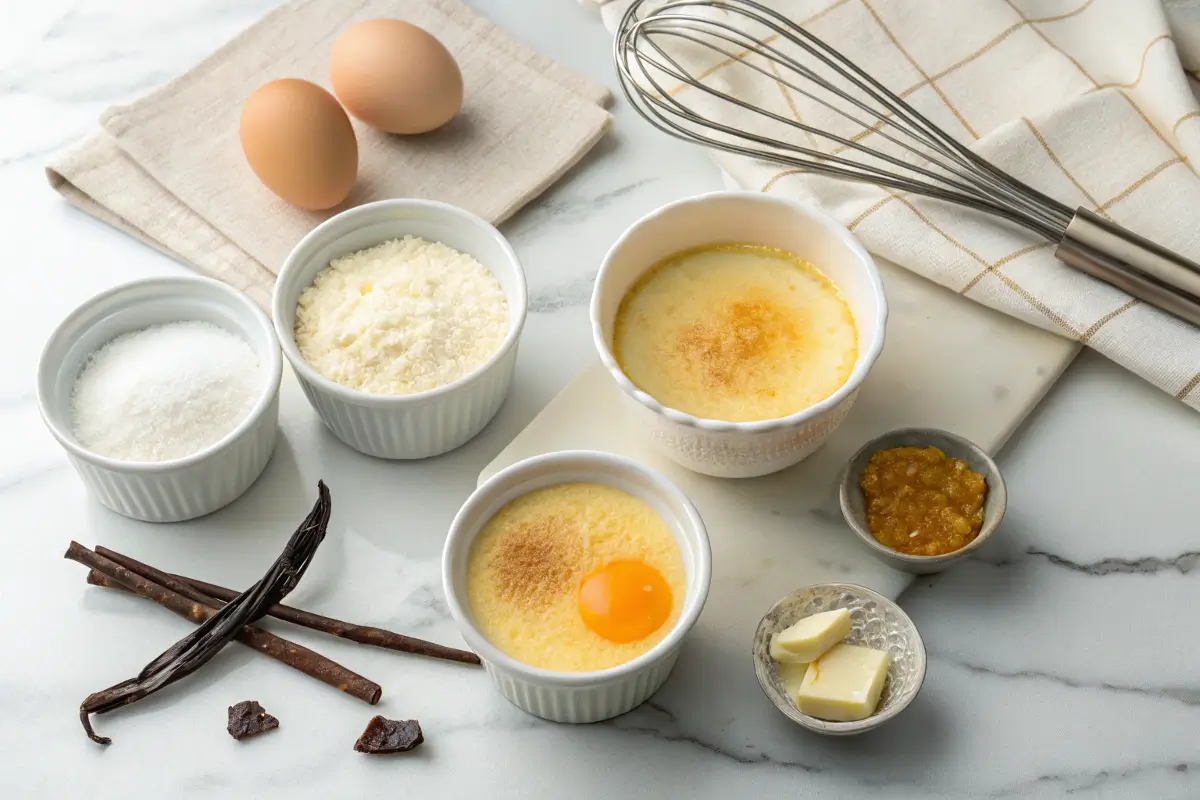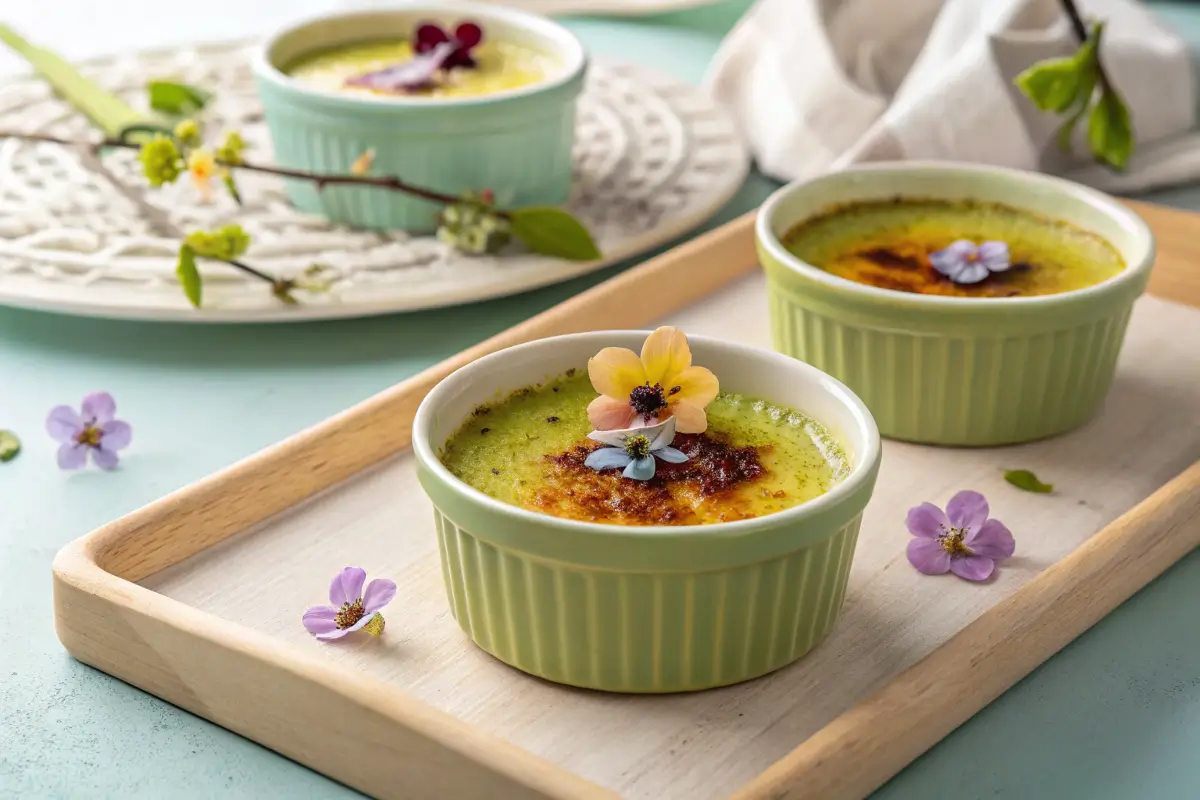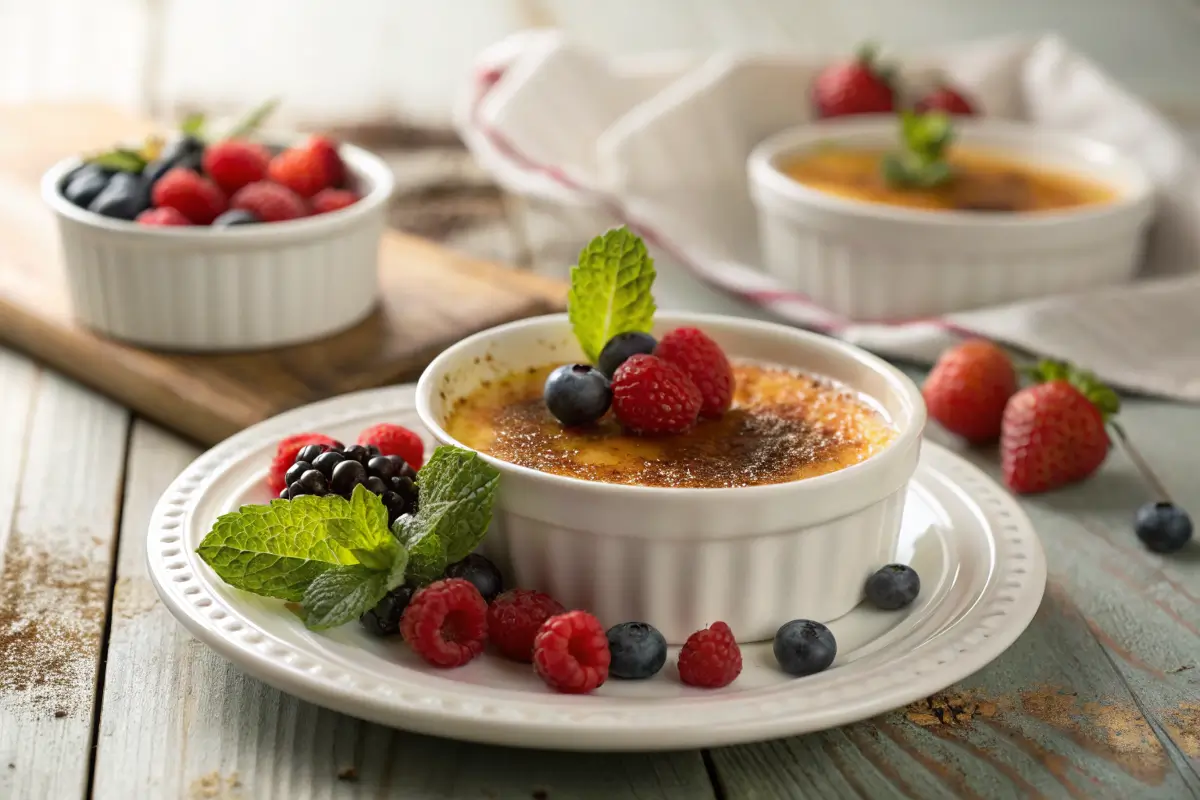Few desserts can rival the allure of crème brûlée. With its silky custard base crowned by a crisp, caramelized sugar crust, this timeless treat has become a symbol of sophistication and indulgence. But what exactly is the secret of crème brûlée? In this article, we’ll explore its fascinating history, delve into its ingredients and preparation, uncover the science behind its magic, and guide you through mastering it at home. Along the way, we’ll also address common pitfalls, FAQs, and modern twists on this classic dish. Let’s dive in!
The Origins and History of Crème Brûlée
Early Beginnings in France
Crème brûlée’s story begins in 1691 when François Massialot, a renowned French chef, first documented the recipe in his cookbook Le Cuisinier Royal et Bourgeois. Originally, this luxurious dessert was prepared with simple yet rich ingredients: cream, egg yolks, and sugar. It became a staple in royal courts, celebrated for its delicate flavor and decadent presentation.
Debates on True Origins
While crème brûlée is often associated with French cuisine, its origins spark debate. In England, a similar dish known as “Trinity Cream” was served at Trinity College, Cambridge, in the 17th century. Spain also boasts its own version, Crema Catalana, featuring a hint of citrus zest and cinnamon. These cultural parallels highlight how diverse influences shaped this dessert over time.
Evolution Through the Centuries
From its aristocratic roots, crème brûlée evolved into a global phenomenon. The dessert saw a resurgence in popularity during the 1980s, thanks to innovative chefs who reintroduced it to restaurant menus. Sirio Maccioni, a prominent restaurateur, played a pivotal role in this revival, transforming crème brûlée into a culinary icon synonymous with fine dining.
Today, it graces menus worldwide, with endless variations showcasing its versatility. From its humble beginnings to its celebrated status, crème brûlée continues to captivate hearts (and taste buds) across cultures.
Understanding the Components of Crème Brûlée
The Silky Custard Base
At the heart of crème brûlée lies its velvety custard base. This luscious foundation is crafted from a harmonious blend of cream, egg yolks, sugar, and vanilla. The cream imparts richness, while the egg yolks provide structure, resulting in a smooth, indulgent texture. Achieving the perfect consistency requires careful attention to ingredient ratios and gentle cooking methods, ensuring the custard sets without curdling.
The Caramelized Sugar Topping
The hallmark of crème brûlée is its crisp, caramelized sugar crust. This thin layer of sugar is evenly sprinkled atop the chilled custard and then caramelized using a kitchen torch or broiler. The heat melts and browns the sugar, forming a brittle, amber-hued shell that contrasts delightfully with the creamy custard beneath. Mastering this technique is essential to unlock the secret of crème brûlée’s signature texture.
Flavor Variations and Enhancements
While the classic crème brûlée features vanilla-infused custard, culinary creativity has led to numerous flavor adaptations. Incorporating citrus zests, such as lemon or orange, introduces a zesty brightness. Infusions of coffee or liqueurs like Grand Marnier add depth and complexity. Additionally, garnishing with fresh berries, edible flowers, or flavored sugars can elevate the dessert’s visual appeal and taste, offering a personalized twist on this timeless favorite.
The Science Behind the Perfect Crème Brûlée
The Role of Egg Yolks in Custard Formation
Egg yolks are pivotal in transforming a simple cream mixture into a cohesive custard. When gently heated, the proteins in the yolks coagulate, thickening the mixture and giving it that characteristic creamy texture. Balancing the proportion of egg yolks to cream is crucial; too many yolks can lead to a dense custard, while too few may result in a runny consistency.
Achieving the Ideal Consistency
Temperature control is paramount in custard preparation. Baking the custard in a water bath, or bain-marie, ensures even heat distribution, preventing the edges from overcooking while the center remains underdone. The water bath’s gentle heat allows the custard to set uniformly, yielding a smooth, tender texture. Monitoring the baking time and removing the custard from the oven when it slightly jiggles in the center will achieve the desired consistency.
Caramelization Process of Sugar
Caramelizing the sugar topping involves a fascinating chemical reaction known as the Maillard reaction. Applying high heat causes the sugar molecules to break down and recombine, forming complex flavor compounds and that distinctive golden-brown color. To avoid pitfalls like burning or under-caramelizing, it’s essential to use an even layer of fine sugar and apply consistent heat, resulting in a perfectly crisp and flavorful crust that complements the creamy custard beneath.
Step-by-Step Guide to Making Crème Brûlée at Home
Gathering Ingredients and Equipment

To embark on crafting crème brûlée at home, first assemble the essential ingredients: heavy cream, egg yolks, granulated sugar, and pure vanilla extract. Additionally, ensure you have the necessary equipment: a mixing bowl, whisk, fine-mesh strainer, ramekins, a baking dish for the water bath, and a kitchen torch or broiler for caramelizing the sugar topping. Proper preparation and having all tools at hand set the stage for a seamless cooking experience.
Preparing the Custard Mixture
Begin by preheating your oven to 325°F (163°C). In a saucepan, gently heat the heavy cream over medium heat until it just begins to simmer; avoid boiling. Meanwhile, whisk together the egg yolks and granulated sugar in a separate bowl until the mixture becomes pale and slightly thickened. Gradually pour the warm cream into the egg yolk mixture, whisking continuously to temper the eggs and prevent curdling. Stir in the vanilla extract for that classic flavor. For a silky smooth custard, strain the mixture through a fine-mesh strainer to remove any unintended lumps.
Baking and Setting the Custard
Evenly distribute the custard mixture into the ramekins, filling each about three-quarters full. Place the filled ramekins into a baking dish, then pour hot water into the dish until it reaches halfway up the sides of the ramekins, creating a bain-marie or water bath. This method ensures gentle, even cooking. Carefully transfer the baking dish to the preheated oven and bake for 40 to 45 minutes, or until the custards are set but still exhibit a slight jiggle in the center. Once baked, remove the ramekins from the water bath and allow them to cool to room temperature. Then, cover and refrigerate for at least two hours, or preferably overnight, to fully set and develop the flavors.
Caramelizing the Sugar Topping
When ready to serve, evenly sprinkle a thin layer of granulated sugar over the surface of each chilled custard. Using a kitchen torch, apply a steady flame to the sugar, moving in a circular motion, until it melts and turns a deep amber color, forming a crisp, caramelized layer. If a torch isn’t available, you can place the sugar-topped ramekins under a broiler set to high heat for 1 to 2 minutes, watching closely to prevent burning. Allow the caramelized sugar to harden for a minute before serving, providing that signature crack when tapped with a spoon.
Common Mistakes and How to Avoid Them
Overcooking or Undercooking the Custard
Achieving the perfect custard consistency requires precise baking. Overcooking can lead to a grainy texture, while undercooking results in a runny custard. To avoid these pitfalls, bake until the custard is set around the edges but still slightly wobbly in the center. What is the secret of crème brûlée? It’s about precision—using an oven thermometer can help ensure accurate temperature, and checking for doneness a few minutes before the recommended baking time can prevent overcooking.
Achieving the Right Sugar Crust
The allure of crème brûlée lies in its contrasting textures, particularly the crisp sugar crust atop the creamy custard. To achieve this, apply an even, thin layer of sugar over the chilled custard. Using too much sugar can result in a thick, hard crust, while too little may not caramelize properly. What is the secret of crème brûlée? The answer lies in mastering the caramelization process, whether using a kitchen torch or a broiler. Keep the flame moving or rotate the ramekins to ensure a perfect, even crust.
Preventing Cracked or Grainy Custard
A smooth, creamy custard is the hallmark of a well-executed crème brûlée. To prevent a grainy texture, avoid overmixing the custard mixture, which can incorporate excess air and lead to an undesirable texture. Additionally, baking the custards in a water bath moderates the heat, preventing the eggs from curdling and resulting in a silky consistency. To avoid cracks, ensure the custards cool gradually; rapid temperature changes can cause the custard to contract and crack. Allowing the custards to cool at room temperature before refrigerating helps maintain their structural integrity.
By being mindful of these common mistakes and following the outlined steps, you can master the art of making crème brûlée at home, impressing guests and satisfying your sweet tooth with this timeless dessert.
Frequently Asked Questions About Crème Brûlée
Can I Make Crème Brûlée Without a Torch?
Absolutely! While a kitchen torch is the traditional tool for caramelizing the sugar topping, you can achieve similar results using your oven’s broiler. Simply place the sugar-topped ramekins on the top rack of the oven and broil on high heat for 1 to 2 minutes, keeping a close eye to avoid burning. Remember, the key to what is the secret of crème brûlée lies in achieving that perfect caramelized crust, whether by torch or broiler.
How Long Can Crème Brûlée Be Stored?
Crème brûlée can be stored in the refrigerator for up to 2 days before serving. However, it’s best to caramelize the sugar topping just before serving to maintain its crisp texture. Cover the custards tightly with plastic wrap to prevent the absorption of refrigerator odors.
Can I Use Alternative Sweeteners or Dairy-Free Options?
Yes, you can adapt crème brûlée to suit dietary needs. Coconut cream or almond milk are excellent substitutes for heavy cream, offering a dairy-free alternative. Similarly, natural sweeteners like maple syrup or honey can replace granulated sugar, although they may alter the flavor slightly. Experimenting with these options can unlock new ways to enjoy this classic dessert.
What Is the Difference Between Crème Brûlée and Crème Caramel?
While both desserts share a custard base, they differ in preparation and presentation. Crème caramel features a layer of caramel sauce baked into the dish, which becomes a syrupy topping when inverted onto a plate. In contrast, crème brûlée boasts a hard, caramelized sugar crust achieved by direct heat, which is served intact and cracked upon eating.
Exploring Modern Twists on the Classic Crème Brûlée

Incorporating Unique Flavors
The versatility of crème brûlée lends itself to endless creative variations. Infusions like matcha, lavender, or pumpkin spice can transform the dessert into something uniquely memorable. For instance, a chocolate crème brûlée offers a rich, decadent twist, while a tropical version with coconut milk and mango puree brings a refreshing, exotic flair. These modern takes keep the dessert exciting and contemporary while respecting its traditional roots.
Creative Presentation Ideas
Presentation is half the pleasure when it comes to desserts. Serve crème brûlée in unconventional containers like espresso cups, hollowed-out fruits, or mini mason jars for an innovative touch. Adding garnishes like edible flowers, flavored whipped creams, or thin chocolate shards enhances the visual appeal. These small changes can make the question of what is the secret of crème brûlée feel fresh and captivating, drawing attention to both its taste and artistry.
The Cultural Significance of Crème Brûlée
A Symbol of Elegance and Sophistication
Crème brûlée has long been associated with luxury and indulgence, earning a spot as a staple on fine dining menus around the world. Its simple ingredients belie its repuftation as a symbol of culinary refinement. The balance of textures—creamy custard and a crisp caramelized sugar crust—reflects a mastery of technique that elevates even the humblest kitchen. This interplay of simplicity and sophistication makes crème brûlée a quintessential dessert for special occasions and celebrations.
Global Influence and Popularity
Though its origins are deeply rooted in European cuisine, crème brûlée has transcended borders, becoming a beloved dessert across continents. Many countries have adapted the recipe to include local flavors and ingredients, creating unique versions that honor their culinary traditions. Whether infused with Asian-inspired matcha or Latin American dulce de leche, each variation showcases the versatility of this classic dessert. The enduring popularity of crème brûlée highlights its universal appeal, cementing its place as a cultural icon.
Why Crème Brûlée Stands the Test of Time
The Perfect Balance of Taste and Texture
One of the reasons crème brûlée remains timeless is its harmonious blend of flavors and textures. The creamy, rich custard contrasts perfectly with the crunchy, caramelized sugar topping, creating a sensory experience that delights with every bite. This balance is a key component of what is the secret of crème brûlée, offering a dessert that is both satisfying and memorable.
An Accessible Yet Impressive Dessert
Despite its sophisticated reputation, crème brûlée is surprisingly easy to make at home, requiring only a handful of ingredients and basic tools. Its ability to impress with minimal effort has made it a favorite among home cooks and professional chefs alike. By mastering the fundamentals, anyone can recreate this iconic dessert, making it an enduring symbol of culinary achievement.
Enduring Appeal Across Generations
Crème brûlée’s timeless charm lies in its adaptability and elegance. It appeals to seasoned dessert enthusiasts and those new to the world of fine dining. Whether served in its classic form or reimagined with modern twists, crème brûlée continues to captivate hearts and palates, ensuring its place in the culinary spotlight for generations to come.
With its rich history, delicate balance of flavors, and endless adaptability, crème brûlée remains a testament to the art of dessert-making. By understanding what is the secret of crème brûlée, we unlock not only the technique but also the timeless magic that has made it a beloved treat worldwide.

